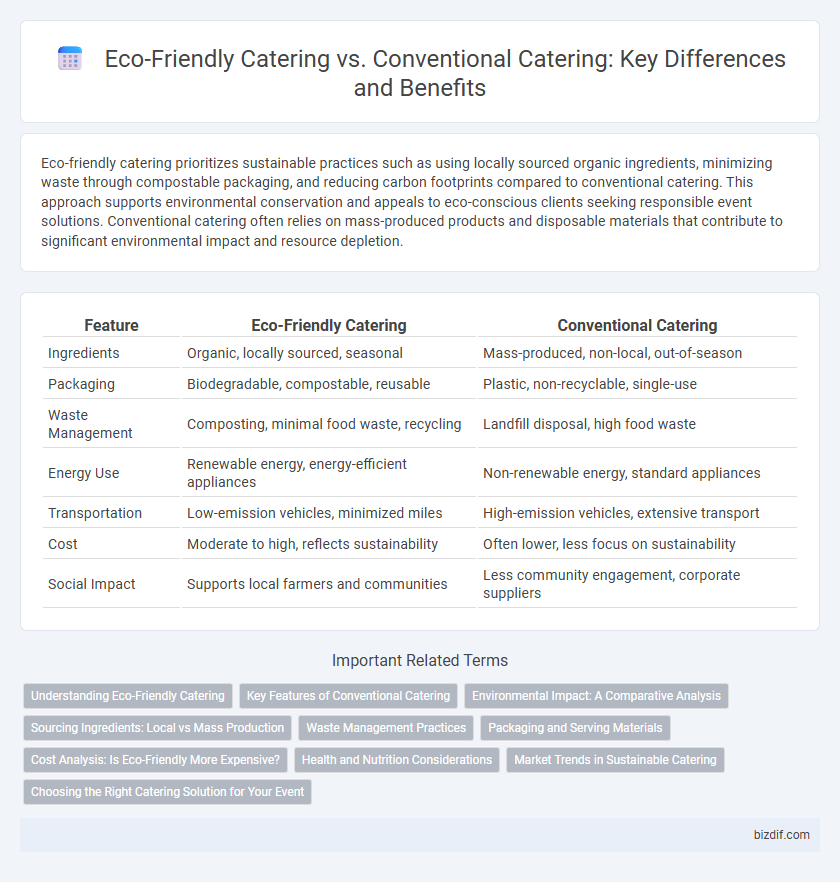Eco-friendly catering prioritizes sustainable practices such as using locally sourced organic ingredients, minimizing waste through compostable packaging, and reducing carbon footprints compared to conventional catering. This approach supports environmental conservation and appeals to eco-conscious clients seeking responsible event solutions. Conventional catering often relies on mass-produced products and disposable materials that contribute to significant environmental impact and resource depletion.
Table of Comparison
| Feature | Eco-Friendly Catering | Conventional Catering |
|---|---|---|
| Ingredients | Organic, locally sourced, seasonal | Mass-produced, non-local, out-of-season |
| Packaging | Biodegradable, compostable, reusable | Plastic, non-recyclable, single-use |
| Waste Management | Composting, minimal food waste, recycling | Landfill disposal, high food waste |
| Energy Use | Renewable energy, energy-efficient appliances | Non-renewable energy, standard appliances |
| Transportation | Low-emission vehicles, minimized miles | High-emission vehicles, extensive transport |
| Cost | Moderate to high, reflects sustainability | Often lower, less focus on sustainability |
| Social Impact | Supports local farmers and communities | Less community engagement, corporate suppliers |
Understanding Eco-Friendly Catering
Eco-friendly catering prioritizes sustainable practices such as sourcing organic, locally grown ingredients and minimizing single-use plastics to reduce environmental impact. This approach integrates biodegradable or compostable serveware and emphasizes waste reduction through careful menu planning and food donation programs. By contrast, conventional catering often relies on mass-produced goods and disposable materials, generating higher resource consumption and waste.
Key Features of Conventional Catering
Conventional catering relies heavily on single-use plastics, non-recyclable materials, and pre-packaged foods that contribute to significant waste and environmental degradation. It typically involves large-scale food production using industrial farming methods, which often depend on synthetic fertilizers and pesticides, increasing the carbon footprint. The supply chain emphasizes efficiency and cost reduction over sustainability, leading to higher greenhouse gas emissions compared to eco-friendly catering alternatives.
Environmental Impact: A Comparative Analysis
Eco-friendly catering significantly reduces environmental impact by utilizing biodegradable packaging, sourcing locally grown organic ingredients, and minimizing food waste through precise portion control. In contrast, conventional catering often relies on single-use plastics, non-organic food products with higher carbon footprints, and excess food production leading to greater landfill waste. Studies reveal that eco-friendly catering can cut greenhouse gas emissions by up to 40% compared to traditional catering methods, making it a sustainable choice for environmentally conscious events.
Sourcing Ingredients: Local vs Mass Production
Eco-friendly catering prioritizes sourcing ingredients from local farms and suppliers, reducing carbon emissions and supporting sustainable agriculture by minimizing transportation distance. Conventional catering often relies on mass-produced ingredients sourced from large-scale industrial farms, which contribute to higher environmental impact due to extensive logistics and intensive farming practices. Choosing locally sourced ingredients ensures fresher produce while promoting eco-conscious consumption within the catering industry.
Waste Management Practices
Eco-friendly catering prioritizes waste reduction through composting, biodegradable packaging, and minimizing single-use plastics, significantly decreasing landfill contributions. Conventional catering often relies on disposable materials and lacks comprehensive recycling or composting programs, leading to higher volumes of food and packaging waste. Sustainable waste management in eco-friendly catering supports environmental conservation and aligns with growing consumer demand for green practices.
Packaging and Serving Materials
Eco-friendly catering prioritizes biodegradable, compostable, or reusable packaging and serving materials, significantly reducing plastic waste and environmental impact compared to conventional catering, which often relies on single-use plastic and non-recyclable packaging. Materials such as bamboo, cornstarch-based containers, and recycled paper products are common in sustainable catering, promoting waste diversion and lower carbon footprints. These choices support responsible resource management and align with growing consumer demand for environmentally conscious event solutions.
Cost Analysis: Is Eco-Friendly More Expensive?
Eco-friendly catering often involves higher upfront costs due to sustainable ingredient sourcing and biodegradable packaging, but it can reduce long-term expenses through waste minimization and energy efficiency. Conventional catering may appear cheaper initially because of bulk purchasing and standardized processes, yet it frequently incurs hidden costs related to environmental impact and regulatory compliance. Careful cost analysis reveals that eco-friendly catering offers competitive value when factoring in sustainability benefits and potential tax incentives.
Health and Nutrition Considerations
Eco-friendly catering prioritizes sourcing organic, locally grown ingredients, reducing exposure to pesticides and promoting higher nutrient retention compared to conventional catering, which often relies on processed and mass-produced foods. This approach supports healthier meal options by emphasizing seasonal, whole foods that boost immune function and overall well-being. Sustainable practices in eco-friendly catering also minimize additives and preservatives, aligning with nutritional guidelines for balanced diets rich in vitamins and minerals.
Market Trends in Sustainable Catering
Eco-friendly catering is rapidly gaining market share as consumers increasingly demand sustainable sourcing, waste reduction, and biodegradable packaging. Trends show a significant rise in plant-based menu options and locally sourced ingredients, reflecting heightened environmental awareness. Conventional catering struggles to compete as corporate clients and event planners prioritize carbon footprint reduction and ethical supply chains.
Choosing the Right Catering Solution for Your Event
Eco-friendly catering prioritizes sustainable sourcing, biodegradable packaging, and reduced food waste to minimize environmental impact, making it ideal for events focused on green values. Conventional catering often offers a wider variety of menu options and may accommodate larger guest lists with established logistical support. Selecting the right catering solution depends on balancing environmental goals, budget constraints, and event size to ensure a successful and responsible dining experience.
Eco-Friendly Catering vs Conventional Catering Infographic

 bizdif.com
bizdif.com